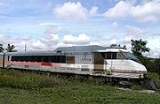
Turboliner
Encyclopedia
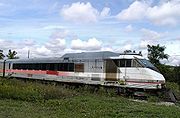
Gas turbine train
A gas turbine train, is a passenger train that uses one or more gas turbines as its main source of power. Few passenger trains use this system today, although there has been one recent prototype built by Bombardier Transportation.-Description:...
sets built for Amtrak
Amtrak
The National Railroad Passenger Corporation, doing business as Amtrak , is a government-owned corporation that was organized on May 1, 1971, to provide intercity passenger train service in the United States. "Amtrak" is a portmanteau of the words "America" and "track". It is headquartered at Union...
. The trains were powered by gas turbine engines
Gas turbine
A gas turbine, also called a combustion turbine, is a type of internal combustion engine. It has an upstream rotating compressor coupled to a downstream turbine, and a combustion chamber in-between....
and ran on diesel fuel. Some were equipped with third rail
Third rail
A third rail is a method of providing electric power to a railway train, through a semi-continuous rigid conductor placed alongside or between the rails of a railway track. It is used typically in a mass transit or rapid transit system, which has alignments in its own corridors, fully or almost...
shoes
Current collector
Electric current collectors are used for trolleybuses, trams, electric locomotives or EMUsto lead electrical power from overhead lines or electrical third rails to the electrical equipment of the vehicles....
to enable entry into the underground tunnels approaching Grand Central Terminal
Grand Central Terminal
Grand Central Terminal —often incorrectly called Grand Central Station, or shortened to simply Grand Central—is a terminal station at 42nd Street and Park Avenue in Midtown Manhattan in New York City, United States...
and New York Penn Station in New York City
New York City
New York is the most populous city in the United States and the center of the New York Metropolitan Area, one of the most populous metropolitan areas in the world. New York exerts a significant impact upon global commerce, finance, media, art, fashion, research, technology, education, and...
. Turboliner service originally started in the 1970s as an effort by Amtrak to update its fleet with faster, more modern vehicles. Since then, the trainsets have undergone several rebuilds with the latest in 2000. As part of a lawsuit settlement between Amtrak and New York State, no Turboliners are currently in revenue service and the partially refurbished fleet is for sale.
History
The Turboliners were closely based on the French ANFAteliers du Nord de la France
Ateliers de Construction du Nord de la France was a French locomotive manufacturer, based at Crespin in northern France. Later known as ANF Industrie or ANF the company was acquired by Bombardier Transportation in 1989 and is now part of Bombardier Transport France S.A.S.-History:Ateliers de...
company's gas-turbine T 2000
SNCF Class T 2000
SNCF Class T 2000 trainsets, also known under their French acronym RTG , were the second generation of turbine-powered trains in France and saw commercial service from 1972 to 2004....
RTG "Turbotrain"
Turbotrain
The Turbotrain was an early French high-speed, gas turbine train.It was born in 1967, for use on France's SNCF intercity lines. There were several versions, four in total with the last exiting service in 2005 and it is the Turbotrain that made advances possible for the TGV.* The experimental...
trainset , including the use of similar Turbomeca
Turbomeca
Turbomeca is a French manufacturer of low- and medium-power gas turbine turboshaft engines for helicopters. The company also produces gas turbine engines for aircraft and missiles, as well as turbines for land, industrial and marine applications...
gas-turbine engines. Despite the high cost of fuel common to all gas-turbine trains, the ANF and Rohr Turboliners had a long history of operation in the United States. With a total of 13 trainsets (6 RTG and 7 RTL) in the U.S. and many more in France (see Turbotrain
Turbotrain
The Turbotrain was an early French high-speed, gas turbine train.It was born in 1967, for use on France's SNCF intercity lines. There were several versions, four in total with the last exiting service in 2005 and it is the Turbotrain that made advances possible for the TGV.* The experimental...
), they also represented one of the largest uses of this type of power in the world, other than the freight-hauling Union Pacific GTELs
Union Pacific GTELs
Union Pacific operated the largest fleet of gas turbine-electric locomotives of any railroad in the world. The prototype, UP 50 was the first in a series built by General Electric for Union Pacific's long-haul cargo services. The prototype was introduced in 1948 and was followed by three series...
. In comparison, two UAC TurboTrain sets operated in the U.S. and five in Canada. The Turboliners also had significantly greater longevity in service than the UAC TurboTrain, operating from 1973 into the 1990s, with one set running until 2002. In comparison, the UAC TurboTrain operated in 1968–76 in the U.S. and 1968–82 in Canada.
RTG Turboliners
The RTG model, an Americanized version of the French RTG Turbotrain (related to the prototype precursor to the very first TGVTGV
The TGV is France's high-speed rail service, currently operated by SNCF Voyages, the long-distance rail branch of SNCF, the French national rail operator....
trainset, the TGV 001
TGV 001
TGV 001 was a high-speed railway train built in France. It was the first TGV prototype and was commissioned in 1969, to begin testing in 1972...
). The RTGs used European-style couplers (buffer
Buffer (rail transport)
A buffer is a part of the buffers-and-chain coupling system used on the railway systems of many countries, among them most of those in Europe, for attaching railway vehicles to one another....
s and turnbuckle
Turnbuckle
A turnbuckle, stretching screw or bottlescrew is a device for adjusting the tension or length of ropes, cables, tie rods, and other tensioning systems. It normally consists of two threaded eyelets, one screwed into each end of a small metal frame, one with a left-hand thread and the other with a...
s) between their cars, due to having been built in France by ANF for use on French railways. However on the cab ends they were modified with standard knuckle couplers and European buffers were removed at those locations. Bells were also added under each cab. Amtrak later installed oscillating headlights on the cab ends for better grade crossing recognition because motorists would often mistake the Turbos' dual headlights with automobiles on the parallel U.S. Rt. 66 on the St. Louis line, resulting in several grade crossing accidents. The oscillating lights were mounted between the original headlights, later changed to above the windshield. In addition the RTG's original French air horns were modified to blow simultaneously instead of alternating as in typical European practice and were later changed to top-mount Nathan P-5's.
A total of six RTG trainsets were purchased from Amtrak by Ford Motor Credit Company
Ford Motor Credit Company
Ford Motor Credit Company is the financial services arm of Ford Motor Company, and is headquartered in Dearborn, Michigan.Its business activities are concentrated primarily in the area of automobile loans in support of its parent company...
and then leased back to Amtrak. Each set consisted of two power cars, two coaches, and a bar/grill car.
RTGs were used on a number of routes originating in Chicago
Chicago
Chicago is the largest city in the US state of Illinois. With nearly 2.7 million residents, it is the most populous city in the Midwestern United States and the third most populous in the US, after New York City and Los Angeles...
in the 1970s and early 80s. The RTG sets began arriving in Chicago in late 1973. The construction of Amtrak's Brighton Park Turbo Facility began around that time. The trainsets operated between Chicago and St. Louis
St. Louis, Missouri
St. Louis is an independent city on the eastern border of Missouri, United States. With a population of 319,294, it was the 58th-largest U.S. city at the 2010 U.S. Census. The Greater St...
, Port Huron
Port Huron, Michigan
Port Huron is a city in the U.S. state of Michigan and the county seat of St. Clair County. The population was 30,184 at the 2010 census. The city is adjacent to Port Huron Township but is administratively autonomous. It is joined by the Blue Water Bridge over the St. Clair River to Sarnia,...
, Detroit, Carbondale
Carbondale
Carbondale may refer to:*Carbondale, California*Carbondale, Colorado*Carbondale, Illinois*Carbondale, Indiana*Carbondale, Kansas*Carbondale, Ohio*Carbondale, Oklahoma, an area in Tulsa, Oklahoma*Carbondale, Pennsylvania...
, Milwaukee, and Toledo
Toledo, Ohio
Toledo is the fourth most populous city in the U.S. state of Ohio and is the county seat of Lucas County. Toledo is in northwest Ohio, on the western end of Lake Erie, and borders the State of Michigan...
(via Detroit) at various times during their life.
The Brighton Park Facility was closed in 1981 and the equipment was moved to Beech Grove
Beech Grove, Indiana
As of the census of 2000, there were 14,880 people, 6,085 households, and 3,839 families residing in the city. The population density was 3,462.5 people per square mile . There were 6,506 housing units at an average density of 1,513.9 per square mile...
, Indiana
Indiana
Indiana is a US state, admitted to the United States as the 19th on December 11, 1816. It is located in the Midwestern United States and Great Lakes Region. With 6,483,802 residents, the state is ranked 15th in population and 16th in population density. Indiana is ranked 38th in land area and is...
, for storage.
During the energy crisis of the late 70s, several modifications were performed to reduce fuel consumption, such as the addition of a higher power and more efficient main engine. This allowed the sets to run with only one of the two main engines operating, resulting in saved fuel. The 380V/50 hertz alternator that supplied head-end power to the coaches was driven by a smaller turbo engine, the Astazou.
After service in the midwest, two RTG trains were retrofitted with RTL style noses, and third-rail capability to enable operation into New York. Renamed RTG II's, one of the modified trainsets later caught fire in New York Penn Station, and as a result the RTG II sets were immediately retired. At least one RTG set has been preserved in a museum in France.
RTL
Seven RohrRohr, Inc.
Goodrich Aerostructures Group, formerly Rohr, Inc., is an aerospace manufacturing company based in Chula Vista, California, south of San Diego...
RTL trains were based on the earlier Amtrak RTG series trains but had American-style couplers
Coupling (railway)
A coupling is a mechanism for connecting rolling stock in a train. The design of the coupler is standard, and is almost as important as the railway gauge, since flexibility and convenience are maximised if all rolling stock can be coupled together.The equipment that connects the couplings to the...
throughout and American-standard (480 volts/60 hertz) head end power as well as a different design powercar cab. The sets operated in revenue service throughout upstate New York
Upstate New York
Upstate New York is the region of the U.S. state of New York that is located north of the core of the New York metropolitan area.-Definition:There is no clear or official boundary between Upstate New York and Downstate New York...
from the 70s into the 90s. One of these original sets were rebuilt into an RTL-II set.
RTL-II
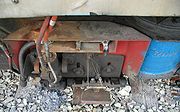
RTL-III
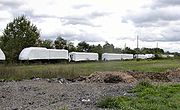
Livery
A livery is a uniform, insignia or symbol adorning, in a non-military context, a person, an object or a vehicle that denotes a relationship between the wearer of the livery and an individual or corporate body. Often, elements of the heraldry relating to the individual or corporate body feature in...
. A prototype was tested on the night of February 15, 2003, reaching 125 mph (201 km/h). Two of these train sets were rebuilt and entered revenue service in April 2003, while a third rebuilt set was sent to Albany
Albany, New York
Albany is the capital city of the U.S. state of New York, the seat of Albany County, and the central city of New York's Capital District. Roughly north of New York City, Albany sits on the west bank of the Hudson River, about south of its confluence with the Mohawk River...
in September of the same year but never entered service. As of September 22, 2004, all three RTL-III trainsets were in storage in Bear, Delaware
Bear, Delaware
Bear is a census-designated place in New Castle County, Delaware, United States. The population was 17,593 at the 2000 census.Originally a small crossroads in a rural area south of Wilmington, the area supported small farms growing mainly corn and cattle...
(39°36′21.3119"N 75°42′0.0216"W) due to problems with the air conditioning system and possibly other systems.
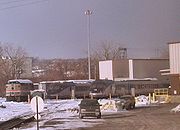
Budd Metroliner
The Budd Metroliner car was an electric multiple unit train designed for first-class, high-speed service on the Pennsylvania Railroad's route between New York City and Washington, DC....
cars to propel the trains into and out of New York's Penn Station using electricity instead of diesel fuel.
The original RTL-III program envisioned seven five-car trains, and Amtrak and New York State DOT attempted to renegotiate the configurations with the possibility of adding an additional coach to existing trainsets. In the summer of 2004, negotiations stopped, and the state of New York sued Amtrak over the alleged lack of support to bring 125 mi/h train service back to the Empire State.
In April 2005, New York State reached a settlement with Super Steel to completely close the rehabilitation project for $5.5 million, to stop work on the project, cover any remaining costs, and move four unfinished trains into storage at a nearby industrial park. This settlement, when added to the $64.8 million previously spent, brought the total amount spent on the project—the results of which were three rehabilitated trainsets and four others in various states of repair—to $70.3 million.
On December 12, 2007, Amtrak settled New York State's lawsuit with a payment of $20 million, and both Amtrak and New York State agreed to commit $10 million each to implement track improvements in the Empire Corridor following the findings of the New York State Senate High-Speed Rail Task Force.
See also
- New York high-speed railNew York high-speed railHigh-speed rail in New York has been a topic that is consistently discussed among legislators, political leaders and in particular, several past governors since the 1990s, but thus far little progress has been made...
- United Aircraft TurboTrain
- Bombardier JetTrainJetTrainThe JetTrain is a Canadian experimental high-speed passenger train created by Bombardier Transportation in an attempt to make European-style high-speed service more financially appealing to passenger railways in North America. It uses the same LRC-derived tilting carriages as the Acela Express...
- TurbotrainTurbotrainThe Turbotrain was an early French high-speed, gas turbine train.It was born in 1967, for use on France's SNCF intercity lines. There were several versions, four in total with the last exiting service in 2005 and it is the Turbotrain that made advances possible for the TGV.* The experimental...
Further information
- http://www.osc.state.ny.us/press/releases/jun03/061203.htm
- http://www.osc.state.ny.us/audits/allaudits/093005/04s10.htm

